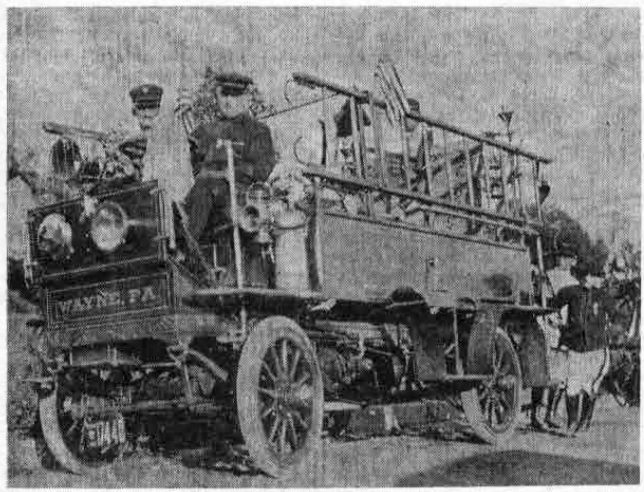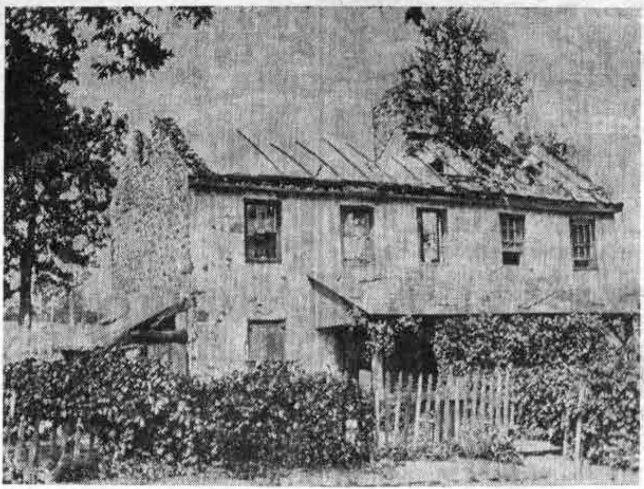The most gala day and the most tragic one in the 50-year history of the Radnor Fire Company are represented by the two pictures shown in today’s column.
 The first picture was taken on Saturday, June 10, 1911, when the Delaware County Firemen’s Association was in the second day of its two-day session, with the Radnor Fire Company as host.
The first picture was taken on Saturday, June 10, 1911, when the Delaware County Firemen’s Association was in the second day of its two-day session, with the Radnor Fire Company as host.
 The second picture was taken on Thursday, April 3, 1930, when the Radnor Fire Company was among the first of those from miles around to arrive on the scene of the disastrous Devon fireworks explosion. But, before the Wayne siren could be sounded to call men and apparatus into action, the explosion had taken the lives of ten employees at the fireworks plant, among them four children under 16 years of age. It was the worst calamity ever to hit the Main Line.
The second picture was taken on Thursday, April 3, 1930, when the Radnor Fire Company was among the first of those from miles around to arrive on the scene of the disastrous Devon fireworks explosion. But, before the Wayne siren could be sounded to call men and apparatus into action, the explosion had taken the lives of ten employees at the fireworks plant, among them four children under 16 years of age. It was the worst calamity ever to hit the Main Line.
Seated behind the wheel of Wayne’s first Chemical and Hose Wagon on Saturday, June 10, was Paul Comins, with Charles Wilkins beside him. The men at the rear or the truck were flag bearers.
At the time of this convention there were 29 member organizations in the Delaware County Firemen’s Association, the largest one-county organization in the entire United States. Most of these fire companies were represented in the big Saturday afternoon parade in Wayne, and many from other neighboring communities as well.
Captain Leonard Haskett, of the Radnor Township Police Department, rode at the head of the procession, to the music of many bands, for its five-mile march “over the broad, beautiful shaded avenues of Wayne and St. Davids.” Immediately behind him rode and marched those visiting firemen who were not in the Delaware county district. Among these were 65 volunteers from Malvern, several of them drawing the hose cart of their company and accompanied by their 27-piece band.
Other interesting participants in the parade were the Bryn Mawr Fire Company, with Fire-Chief Israel H. Supplee at their head and with their handsome steamer and combination truck. This first division of the parade also included, the “Darby Ram”, said to be the oldest piece of firefighting apparatus in existence anywhere. In great contrast to this was the new $7,000 auto truck of the Montgomery Hose and Steam Fire Engine Company, of Norristown, which made its first public appearance at this parade.
The second division of the parade was made up entirely of representatives from the Delaware county fire companies. Darby was chosen to lead it, since its fire company is one of the oldest in the country. Clifton Heights had the distinction of having the only ambulance in the parade. Last in line was the Radnor contingent, with its 45 men dressed in their green uniforms, black gauntlets and shining black puttees.
At the close of the march, which covered all the main streets of North and South Wayne, all bands, banners and apparatus were massed for a march from Louella avenue along Lancaster avenue to the Opera House corner, and thence to the school grounds, where refreshments were served.
Not fire, but explosion caused the wreckage of this house on Devon Hill on April 3, 1930. It was but one of a number of small houses just across the road from the fireworks plant that were so badly damaged that they had to be razed to the ground afterwards.
The largest individual property loss was to the Betner Paper Box Company (now the Betner Division of Continental Can Company) about a quarter of a mile distant from the explosion, where the entire interior of the plant was wrecked and 40 employees were injured. Other buildings that were severely damaged were the office of the Lobb lumber yard and the show rooms of the Packard Motor Company. Mrs. Charles M. Lea’s residence in Devon was damaged to the extent of about $50,000.
The immediate cause of the explosion was probably known only to a few of the many victims of this great tragedy. The plant had long been a community menace with its large quantities of black powder and other explosives stored on the premises. Unbelievable as it may seem, gas stoves were used in heating the plant and there were also gas jets in the drying room. At the inquest, the Coroner’s jury gave one or more or these factors as the probable cause of the explosion.
Fire companies from the entire general vicinity made record runs to the scene, with Radnor among the first to arrive. Once there they repeatedly risked their lives in the inferno of blazing fireworks. While the actual fire was confined to the plant itself, scattered debris started numerous field fires to add to the difficulties of the firemen. And once the fire was under control the work of clearing the grounds of explosive material had to be done by men especially qualified for the work.
The fireworks plant was never rebuilt. The cleared area is now the site of numerous small new homes which are reached by taking a right hand turn onto Conestoga road just west of the overpass of the P & W railroad on Lancaster Pike In Strafford.
